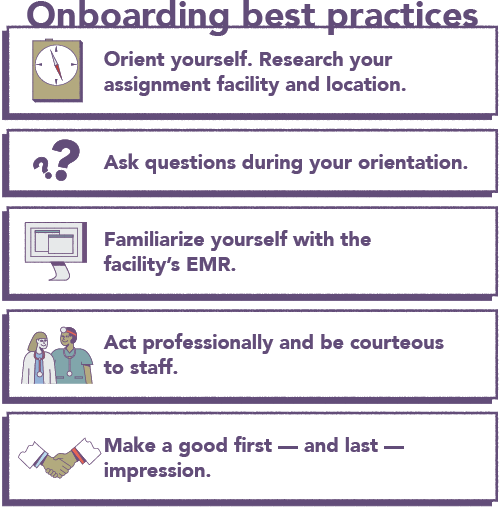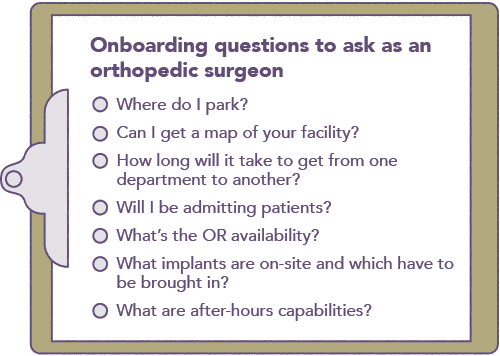
Orthopedic surgeon Dr. Nicholas Kusnezov offers his best practices for your next locum tenens assignment onboarding.
New locum tenens assignments can often seem daunting, especially in larger and busier facilities. In my experience, the quicker you get to know the lay of the land, the more comfortable you will feel, and the smoother your assignment will be.

Orient yourself to the locum assignment facility and location
First and foremost, do your due diligence in researching your assignment facility and location. Take the time in the beginning to find out where all the essential locations are and how to reach all the essential personnel that you will need to. For me, as an orthopedic surgeon, the key locations that I always map out are the ER, OR, and orthopedic ward. The key contacts I always need are the hospital operator, ER, OR front desk, and the house supervisor. From a surgical standpoint, this also involves getting the contacts of your local reps.
You’ll often be able to manage all of this during orientation. Sometimes your orientation runs concurrently with your other obligations, such as call coverage. However, use orientation as an opportunity to figure out the logistics of your assignment. Figure out where to park, walk the facility, map it out, and get an idea of how to get between areas and how long it takes to do so. Having the foresight to do this ahead of time will serve to optimize your time and minimize stress.
RELATED: How do I prepare for a locum tenens assignment?
Learn the facility’s EMR system and workflow
Beyond this, you will want to figure out the nuances of the facility. Of these, most notably are familiarizing yourself with the medical record system and the workflow.
There are many types of medical record systems that you will encounter. Most are often a hybrid between electronic and vestiges of paper documents. Figure out which type of documentation you need to be doing and how to do it. Some facilities use paper consents, some require electronic verification forms, some will add cases to the schedule for you, and others will expect you to add them.
RELATED: What can I expect in the locum tenens onboarding process?
Ask questions — and lots of them — during locum tenens orientation
Additionally, you’ll want to become familiar with the workflow in the facility. Some of the important questions that you should explore while becoming acquainted with the facility include:
- Are you going to be admitting patients or is another service?
- Will patients go directly to the ward or to the operating room?
- What is the operating room availability and how quickly can you take a patient from the emergency room to the operating room?
- What implants live at the facility and which will have to be brought in?
- What are the after-hours capabilities in terms of staff for urgent or emergent surgical cases?
Your goal should be to blend seamlessly and not be disruptive of the native workflow at the institution.
RELATED: How to be the best locums doctor people have worked with
Onboarding tips for a locum tenens orthopedic surgeon

Make sure you and the institution discuss your goals for the assignment. For instance, a hospital may be interested in increasing their total joint arthroplasty volume, while you are instead looking to do chiefly hand cases. It’s important that these goals are elucidated, and it’s ideal if they are comparable or at least reconcilable. It may be that your initial goals are beyond the capabilities of the hospital as it stands, but a better understanding of these goals may drive hospital-based improvements and facilitate this for future assignments there. You will find that physicians have an enormous capacity to facilitate positive changes in hospital efficiency, capabilities, and patient care.
Work to understand and clarify the capabilities of the hospital and how that system specifically works. For instance, this may involve verifying what severity of trauma and degree of patient comorbidities the institution is comfortable dealing with, both operatively and post-operatively.
Additionally, weekend staffing and capabilities should be elucidated ahead of time. It is important to eliminate ambiguity prior to starting so you aren’t overwhelmed with situations well beyond what you expected and, vice versa, so you don’t overwhelm the system with situations beyond which the hospital is capable of handling.
Leave a good first — and lasting — impression as a locum tenens doctor
Finally, and perhaps most importantly, medicine is a business relationship. Always act professionally. Make sure that you make a good first impression and establish a good working rapport with the other staff at the facility. Whether it be nursing staff or physicians, they are calling you because you are a subject matter expert. They need your help, your expertise, and you have the opportunity to make a positive impact and streamline patient care. Be reliable, punctual, and respectful. Some of the most common issues about locum doctors that I hear about are physicians being unreachable and late or rude.
Even if you don’t plan on going back to cover the facility in the future, remember, that medicine is a small tight-knit field. Your reputation will be established quickly and often precedes you.
When in doubt, ask for help. We are all here for the same reason — to deliver the most effective and efficient patient care possible.


